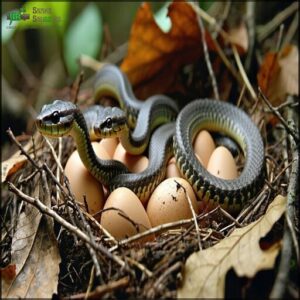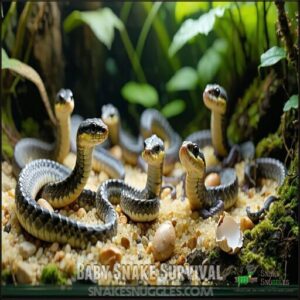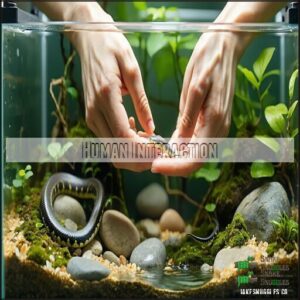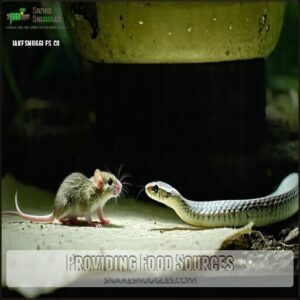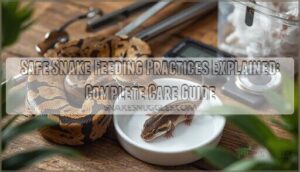This site is supported by our readers. We may earn a commission, at no cost to you, if you purchase through links.

They don’t need to feed them right away—they’re still digesting their yolk sacs. Once they’ve had their first shed (7-10 days), offer appropriately sized prey items like pinkie mice or small insects.
Provide shallow water dishes and multiple hiding spots. Unlike mammals, most newborn snakes are completely independent—nature’s truly self-sufficient little miracles! The key differences between caring for various snake species might surprise even experienced reptile enthusiasts, including the need for specific care that is species-specific and understanding that snakes are completely independent.
Table Of Contents
- Key Takeaways
- Snake Reproduction Basics
- Newborn Snake Care
- Baby Snake Development
- Snake Parenting Styles
- Environmental Factors
- Baby Snake Survival
- Human Interaction
- Spiritual Significance
- Snake Breeding Tips
- Post-Hatching Care
- Frequently Asked Questions (FAQs)
- What do newly hatched snakes eat?
- How to keep a baby snake alive?
- What happens to baby snakes when they hatch?
- How long can a hatchling snake go without food?
- Do baby snakes need special lighting requirements?
- Will siblings fight when housed together?
- How often should newborns shed skin?
- Can baby snakes recognize their handlers?
- When do newborns first accept food?
- Conclusion
Key Takeaways
- Wait until after first shed (7-10 days) before feeding your newborn snakes, as they’re still digesting yolk sacs from birth.
- Maintain species-appropriate temperature gradients (typically 75-85°F) and humidity levels (50-70% for most species) to ensure proper development and healthy shedding.
- Provide shallow water dishes and multiple hiding spots immediately after hatching, as newborn snakes are completely independent with no parental care.
- Offer appropriately sized prey items like pinkie mice or small insects that match your snake’s girth once they’ve had their first shed, feeding every 5-7 days depending on species.
Snake Reproduction Basics
Snake reproduction varies by species, with some laying eggs and others giving birth to live young.
Understanding the process, from fertilization to hatching or live birth, helps you provide the best care for newborn snakes.
Egg-Laying Process
A snake’s egg-laying process is fascinating.
Eggs are soft with leathery shells, suited for their environment. Clutch sizes vary, with small snakes laying up to 30 eggs and larger ones up to 100.
Before egg deposition, some snakes build rudimentary nests. Most species lay eggs once or twice annually, leaving them to incubate, ensuring the continuation of newborn snake care naturally, which is a part of their environment.
Live Birth Process
When a live birth occurs, snake embryos develop internally, relying on yolk sacs for nourishment instead of a placenta.
Membrane function guarantees neonate viability until birth.
These tiny hatchlings, born ready to face the world, skip parental care entirely.
While birthing complications are rare, it’s imperative to guarantee a suitable habitat for immediate newborn snake care, including proper feeding and environmental stability, to ensure proper feeding.
Incubation Period
When caring for snake eggs, precise incubation is key.
A controlled environment guarantees hatching success.
Here’s what to focus on:
- Temperature Control: Keep it between 78–84°F for most species.
- Humidity Balance: Maintain 70–90% to prevent eggs from drying.
- Egg Handling: Avoid rotating eggs; it harms embryos.
- Incubation Length: Anticipate 57 days on average.
- Snake Incubation Setup: Use specialized incubators for consistency.
Newborn Snake Care
Newborn snakes are entirely independent from the moment they hatch, relying on their instincts to survive in their environment.
They receive no parental care, so it’s up to you to provide a safe habitat that meets their basic needs.
Immediate Independence
Once hatchlings emerge from their eggs, they’re on their own.
Baby snake care hinges on understanding their instinctual survival and solitary nature. Without parental guidance, they rely on rapid adaptation to their early diet—tiny prey like insects or worms.
Be cautious, as their venom potential exists from birth for some species. Some species show maternal care, lasting up to two weeks.
Snake independence is remarkable yet challenging from the start.
No Parental Care
After hatching, baby snakes are on their own.
Born ready, baby snakes face the world solo, relying only on instinct to hunt, hide, and survive.
Unlike mammals, snakes abandon their eggs or young, relying on instinctive survival strategies. This lack of parental care boosts reproductive frequency, giving offspring independence to adapt and thrive.
Without guidance, newborn survival instincts kick in, ensuring they meet challenges like newborn snake feeding. It’s nature’s way of promoting evolutionary advantages.
This unique approach allows snakes to thrive in various environments, making them highly adaptable creatures, with a strong will to survive, driven by their innate ability to adapt and thrive.
Self-Defense Mechanisms
Newborn snakes are surprisingly equipped for survival, even without parents around.
Their instinctive self-defense mechanisms kick in right away, keeping predators at bay.
- Venom potency: Some baby snakes can deliver venom with precision if threatened.
- Strike accuracy: Tiny but fierce, their strikes are quick and targeted.
- Camouflage techniques: Their patterns and colors help them blend into surroundings seamlessly.
Baby Snake Development
When baby snakes hatch, they grow quickly, but their rate and size depend on their species and environment.
Their patterns and colors, which help them blend into their surroundings, often resemble those of adult snakes, with environment being a key factor.
Growth Rate
Snake growth rate depends on hatchling size, feeding frequency, and environmental impact.
Faster heart rates post-hatching often mean slower growth, impacting overall lifespan factors. Initial shedding and regular baby snake feeding are essential for proper development.
Providing stable environmental conditions during snake hatching care guarantees newborn snake health.
Slower incubation leads to slightly larger, more robust hatchlings, ready to thrive independently, which is crucial for their overall development.
Size Variation
Baby snakes vary widely in size depending on species differences and environmental factors.
Hatchling length usually ranges from a few inches to over a foot.
A newborn copperhead, for instance, has a distinct yellow tail.
Growth depends on:
- Species-specific traits.
- Availability of an appropriate initial diet.
- Predation vulnerability shortly after birth.
- Proper newborn snake habitat setup.
- Consistent snake hatching care to support development.
Smaller hatchlings often face greater survival challenges due to their size and other factors, making proper care essential for their development.
Coloration and Patterns
Born with camouflage variations, baby snakes often sport muted colors like reddish-brown or grey.
Baby snakes emerge with muted colors, blending seamlessly into their surroundings, a stunning survival feature right from birth.
Some snake hatchlings, like kingsnakes, wow with bright orange patterns, while others show faint diamond shapes.
Over time, ontogenetic changes, such as color shifts post-hatch, highlight regional differences.
Some newborn snakes even display aposematic coloration—warning predators of their venomous nature—making their unique patterns invaluable for survival.
Snake Parenting Styles
You might be surprised to learn that most snakes don’t stick around to raise their young.
Whether they lay eggs or give live birth, snake parenting is more about ensuring survival through strategic reproduction than providing care, which can be seen as a unique aspect of their reproduction strategy.
Oviparous Snakes
Oviparous snakes develop eggs internally before laying them in sheltered spots.
Their nesting behavior guarantees the clutch size, often 10–30 eggs, thrives. To boost hatching success, monitor incubation temperature carefully, as it drives egg development.
- Warm eggs gently around 80–90°F.
- Avoid flipping eggs; embryos attach inside.
- Keep the hatchling snake habitat moist.
- Provide safe, tiny hides post-hatching, ensuring a successful start for the young snakes, which is crucial for their survival.
Viviparous Snakes
Unlike egg layers, viviparous snakes grow their babies inside, using internal development and placental analogues.
After a meaningful gestation period, they give live birth.
Viviparous species invest less maternal time, as newborns are independent.
However, birth frequency varies.
Your focus should be on ensuring a safe baby snake habitat, maintaining health and feeding.
Here’s a quick comparison of oviparous and viviparous traits:
| Feature | Oviparous Snakes | Viviparous Snakes |
|---|---|---|
| Development Type | External (Eggs) | Internal |
| Maternal Investment | Minimal | Slightly Higher |
| Birth Style | Egg Laying | Live Birth |
| Care Post-Birth | Abandoned Quickly | None |
| Common Example | Pythons | Boa Constrictors |
Parthenogenesis
Parthenogenesis is nature’s way of skipping the need for two parents.
Some snake species, like the Brahminy blind snakes, are all-female and reproduce through asexual reproduction. While it limits genetic diversity, it provides an evolutionary advantage in isolated habitats.
Sperm storage allows females to delay fertilization, even in parthenogenic species that don’t require it.
Hatching baby snakes from parthenogenesis still require the same care as others, though this phenomenon has fascinating conservation implications for endangered species.
Environmental Factors
You need to carefully manage temperature, humidity, and food to create the perfect environment for your newborn snakes.
These factors directly affect their survival, growth, and overall health, so it’s essential to get them just right, ensuring the perfect environment for your snakes.
Temperature Influence
Maintaining the right incubation temperature is essential for hatchling snake health.
A thermal gradient of 88–90°F guarantees proper development, influences sex determination, and boosts metabolic rates.
Too high or low can harm hatchling health and feeding.
Stable temperatures protect against deformed hatchlings, guaranteeing success.
Snake eggs thrive when carefully monitored, making temperature control your top priority for successful hatching.
Humidity Levels
After hatching, humidity levels matter so much for hatchling snake health.
Low moisture risks dehydration, while excessive dampness sparks mold. Aim for 55-65% humidity with these tips:
- Use a hygrometer for accurate calibration.
- Mist enclosures sparingly for proper hydration needs.
- Avoid shedding problems by supporting smooth shifts.
- Add sphagnum moss to prevent dryness without overwatering.
Keep conditions steady for thriving snakes! Lignocel is ideal for humidity control.
Food Availability
After checking humidity levels, focus on food availability.
Hatchling snakes rely on appropriately sized prey, like small insects or pinkie mice, to match their nutritional needs.
Offer food every 5–7 days to support baby snake health.
Monitor hunting skills closely, as some struggle initially.
Avoid overcrowding to reduce cannibalism risks, ensuring each snake thrives without competition or stress.
Baby Snake Survival
You’ll need to protect your newborn snakes from predators, starvation, and harsh environmental conditions during their first few weeks of life when mortality rates are highest.
Unlike mammals, these independent creatures receive no parental care and must rely on their instincts from birth, making proper habitat setup and feeding schedules essential for their survival.
Predation Risks
While temperature and humidity form the foundation of your hatchling’s environment, predation risks pose the most immediate threat to their survival.
Newborn snakes face significant vulnerability due to their small size, making them easy targets for various predators.
Research shows that incubation temperature directly affects a baby snake’s ability to evade threats – those incubated at medium temperatures typically demonstrate better predator detection and escape behaviors than others.
Your terrarium’s security is their first defense against this primary survival challenge, providing a safe environment where they can grow and develop without the constant threat of predation.
Starvation Threats
After escaping predators, baby snakes face another deadly challenge – starvation.
Unlike mammals, newborn snakes receive zero parental feeding assistance.
They rely on yolk absorption for initial nutrients, but must quickly develop hunting skills.
You’ll need to offer appropriately sized prey (smaller than the snake’s head) within 5-7 days after hatching.
First feeding is critical – if hatchlings don’t eat within two weeks, their survival chances drop dramatically.
Environmental Hazards
Newly emerged hatchlings face numerous environmental hazards in both wild and captive settings.
Snake dehydration occurs quickly in dry conditions, while extreme temperatures can be fatal.
Your snake enclosure must maintain proper humidity (50-70%) and temperatures (75-85°F) to prevent stress.
Habitat loss, pollution impact, pesticide exposure, climate change, and invasive species threaten wild populations.
Provide adequate snake shelter with multiple hiding spots to help your hatchling feel secure.
Human Interaction
You’ll need to handle newborn snakes with extreme care as they don’t recognize humans and rely solely on instinct from birth.
Unlike mammals, these independent creatures won’t form bonds with you, so your interactions should focus on providing proper habitat conditions rather than attempting to socialize them.
Snake Infestations
While baby snakes on their own can be harmless, finding multiple hatchlings often signals an infestation. Identifying infestations early helps protect both you and the newborn snakes.
Look for these warning signs:
- Multiple shed skins in dark, secluded areas
- Small droppings that resemble bird waste
- Distinctive musky odor in enclosed spaces
- Unusual pet behavior (barking, pawing at walls)
Professional help is recommended when dealing with multiple baby snakes, as proper newborn snake handling requires expertise.
Preventing Snake Entry
To secure your home against snakes and protect your hatchling snake collection from escaping, focus on these key prevention methods.
Seal entry points thoroughly, especially around doors, windows, and utility penetrations.
| Prevention Method | Effectiveness | Maintenance Required | Cost | Difficulty |
|---|---|---|---|---|
| Seal Entry Points | Very High | Yearly Inspection | Low | Medium |
| Snake Repellents | Moderate | Monthly Application | Medium | Low |
| Yard Maintenance | High | Weekly | Low | Medium |
| Mesh Barriers | High | Bi-annual Checks | Medium | High |
| Professional Exclusion | Very High | One-time | High | Low |
The table provides a summary of different prevention methods, including their effectiveness, required maintenance, cost, and difficulty level, to help you make informed decisions about securing your home and protecting your snake collection.
Safe Removal Methods
When faced with baby snakes indoors, use humane trapping methods rather than attempting direct capture.
Place sticky traps in corners, but cover with vegetable oil to release hatchlings safely. For DIY methods, use a broom and bucket for distance.
Snake identification is essential before handling—newborn venomous species can be dangerous. Consider professional relocation services, especially for multiple hatchlings.
After removal, implement preventative measures to avoid repeat visits.
Spiritual Significance
You’ll find that many cultures view baby snakes as powerful symbols of renewal and transformation, representing new beginnings in your spiritual journey.
When caring for newborn snakes, you’re not just tending to a reptile but connecting with an ancient symbol that has represented healing and rebirth throughout human history.
Symbolism of Baby Snakes
While dealing with real snakes requires practical knowledge, the symbolism of baby snakes carries deep meaning across cultures.
These tiny creatures represent powerful concepts:
- New beginnings – Baby snakes emerging from eggs symbolize fresh starts and renewal
- Transformation – Their birth process represents personal growth and change
- Potential growth – Their small size contains the promise of future development
In many spiritual beliefs, witnessing a baby snake hatching signals positive change and opportunities for personal evolution in your life.
Cultural Associations
Throughout human history, snakes have woven themselves into cultural narratives worldwide.
You’ll find these reptiles appearing as powerful symbols across diverse societies.
| Culture | Snake Symbolism | Cultural Impact | Religious Depictions | Folklore Connections |
|---|---|---|---|---|
| Chinese | Wisdom, fortune | Zodiac sign | Dragon-like deities | Protection symbols |
| Greek | Healing, medicine | Asclepius rod | Apollo’s oracle | Medusa’s hair |
| Hindu | Energy, kundalini | Life force | Shiva’s necklace | Nagas (serpent deities) |
| Egyptian | Royalty, protection | Pharaoh’s crown | Wadjet goddess | Afterlife guardians |
| Native American | Transformation, fertility | Rain ceremonies | Earth creators | Tribal symbols |
The table highlights the diverse societies and their respective associations with snakes, showcasing cultural narratives and religious depictions that feature snakes as significant elements, often symbolizing powerful and profound concepts.
Snake Breeding Tips
You’ll need healthy adult snakes at least 2-3 years old and proper incubation conditions to breed snakes successfully at home.
When handling eggs, keep them in the same position they were laid and wash your hands first to prevent bacterial contamination that could harm the developing snakes, ensuring proper incubation conditions.
Choosing Suitable Species
While spiritual meanings matter, selecting the right species for breeding is your first practical step.
For successful snake care from egg to hatchling, choose wisely:
- Start with beginner snakes like corn snakes or ball pythons that forgive minor husbandry mistakes
- Consider size constraints – avoid species growing beyond 6 feet if space is limited
- Prioritize docile temperaments when handling baby snakes will be necessary
Venomous species aren’t suitable for novice breeders. Understanding a snake’s unique temperament is essential for safe handling.
Replicating Natural Habitat
Now that you’ve selected the right species for breeding, creating the perfect home environment is your next step.
To replicate a natural habitat for your snakes, set up a proper temperature gradient (75-90°F depending on species) and maintain consistent humidity control (50-70%).
Understanding thermal regulation needs is vital for their well-being.
Choose appropriate substrate selection like coconut husk or aspen shavings. Don’t forget hiding places—snakes need security!
Proper lighting needs vary by species, so research what your hatchling snake needs for ideal development.
Handling Eggs Safely
With your natural habitat set up, proper egg handling becomes your next focus. Always wash your hands before touching snake eggs to prevent bacterial contamination.
Maintain the original egg orientation as you found them—turning them can harm developing embryos. Handle eggs with extreme gentleness, as the shells are often soft and easily damaged.
For the best results, consider using a specialized incubator to maintain consistent temperatures. During incubation, minimize disturbances to guarantee the best chance of healthy snake hatchlings.
Post-Hatching Care
You’ll need to create the right environment for your newborn snakes by carefully monitoring temperature, maintaining proper humidity, and offering appropriate food sources.
Unlike many other pets, baby snakes are completely independent from birth and will require specific conditions that mimic their natural habitat to thrive in captivity, which includes carefully managing their environment to ensure they have the best chance of survival with the right humidity.
Monitoring Temperature
Now that your eggs have hatched, temperature monitoring becomes your top priority for healthy hatchling snake shedding. The ideal range varies by species – Ball Pythons need 86-90°F while Corn Snakes thrive at 78-84°F.
Always maintain temperature gradients in the enclosure. Species-specific research is essential for successful incubation.
- Thermostat calibration prevents devastating overheating risks
- Your careful monitoring keeps tiny hearts beating strong
- Proper basking spots support successful newborn snake shedding
- Temperature directly impacts feeding response and digestion
- Even small errors can mean life or death for these vulnerable creatures
Maintaining Humidity
Proper humidity levels represent the lifeline for your hatchling snakes during their vulnerable early days.
Without adequate moisture, they’ll struggle with shedding and hydration.
| Species Type | Ideal Humidity | Monitoring Method | Hydration Solution |
|---|---|---|---|
| Desert species | 30-50% | Digital hygrometer | Light misting twice weekly |
| Tropical species | 60-80% | Combo hygrometer/thermometer | Daily misting |
| Semi-aquatic | 70-90% | Bluetooth monitoring system | Water bowl plus substrate misting |
| Temperate species | 40-60% | Analog dial gauge | Humid hide box |
The table outlines the specific humidity levels and care requirements for different species of snakes, including desert, tropical, semi-aquatic, and temperate species.
Providing Food Sources
After hatching, your baby snakes must hunt independently.
Offer appropriately sized prey matching their girth – typically small mice, earthworms, or insects.
For reluctant eaters, try scented rodents or "frog juice."
Feed hatchlings every 5-7 days, depending on species.
Some will eat frozen-thawed prey, while others (especially those with heat pits) require live food.
Consider specialized snake food for ideal nutrition.
Present meals in low light conditions when snakes show signs of hunger.
Frequently Asked Questions (FAQs)
What do newly hatched snakes eat?
Your tiny reptilian explorers, fresh from their shells, won’t need your help finding food.
They’ll hunt small insects, worms, baby rodents, or tiny amphibians depending on their species—all independently from birth.
How to keep a baby snake alive?
You’ll need to maintain proper temperature (75-85°F), humidity (50-70%), and a secure enclosure with hiding spots.
Offer appropriately sized prey items and clean water.
Handle minimally and monitor for health issues.
What happens to baby snakes when they hatch?
Like tiny dragons emerging from their fortress, baby snakes are independent from birth.
They’ll fend for themselves immediately, relying on instincts to hunt small prey and find shelter without any parental care, which makes them quite independent.
How long can a hatchling snake go without food?
Most hatchling snakes can survive 1-2 weeks without food. Their yolk sac reserves sustain them initially, but you’ll want to offer appropriate prey items once they’ve had their first shed.
Do baby snakes need special lighting requirements?
70% of snake species lay their eggs in hidden spots.
You’ll need to provide UVB lighting for 8-12 hours daily, mimicking natural sunlight patterns for proper development and calcium absorption in baby snakes.
Will siblings fight when housed together?
You’ll likely see sibling snakes fight when housed together. They’re naturally solitary and can become territorial, possibly injuring or even cannibalizing each other. It’s best to separate them after hatching.
How often should newborns shed skin?
Like clockwork ticking away, your newborn snake will shed its skin every 1-2 weeks initially, then gradually less often. You’ll notice their eyes turning cloudy before each shed cycle begins.
Can baby snakes recognize their handlers?
Unlike mammals, baby snakes don’t recognize specific handlers.
You’ll notice they rely on instinct rather than bonding.
They can become accustomed to your scent and handling, but won’t form emotional attachments like pets do, which is based on their inability to form emotional bonds.
When do newborns first accept food?
Like tiny dragons awakening from their slumber, newborn snakes typically accept their first meal about 7-14 days after hatching.
You’ll need to wait until they’ve shed their first skin before offering food.
Conclusion
Like tiny serpents finding their path, caring for newborn snakes after hatching requires attention to detail.
You’ll need to maintain proper temperature gradients, humidity levels, and provide appropriate hiding spots.
Remember, these independent creatures don’t need feeding until after their first shed.
Each species has unique requirements, so research is essential.
With proper care, your newborn snakes will thrive in their new environment, growing into healthy adult specimens that reward your dedication with fascinating behavior.
- https://community.morphmarket.com/t/advice-for-beginners-snakes/36667
- https://qualitycage.com/blogs/quality-snake-care/best-pet-snakes?srsltid=AfmBOopYWx7KleVNBzLkN3MuxURhgFFBhqEWT-NGpTZFY2FxQxz9m18i
- https://incubatorwarehouse.com/pages/reptile-incubation-time-and-temperature?srsltid=AfmBOoqNI1ak0V423yQgfxBX-48KDG63wL8zrVSeMvf0Ztpg16gEnJft


